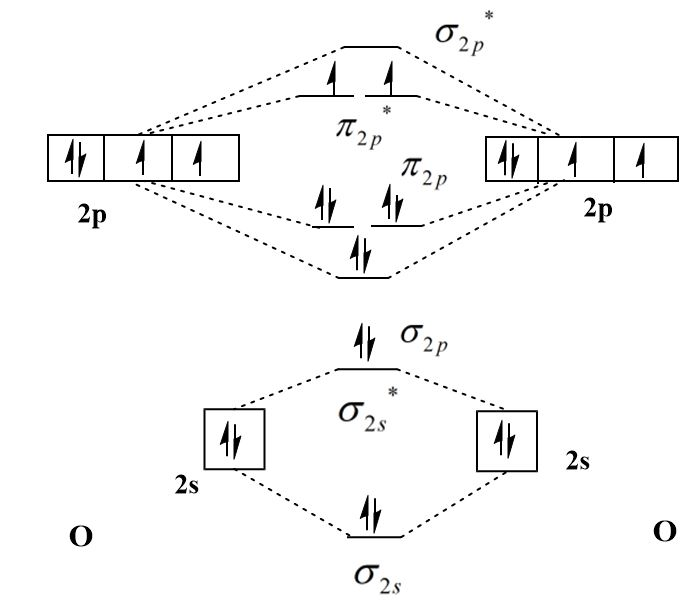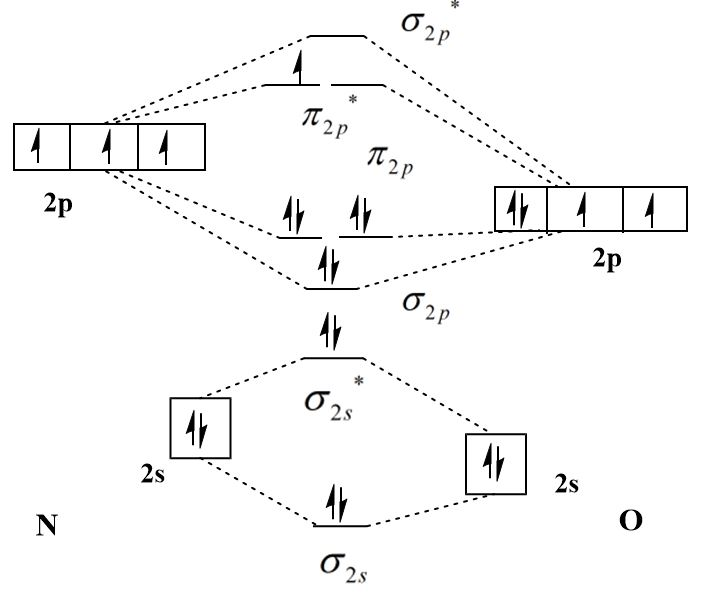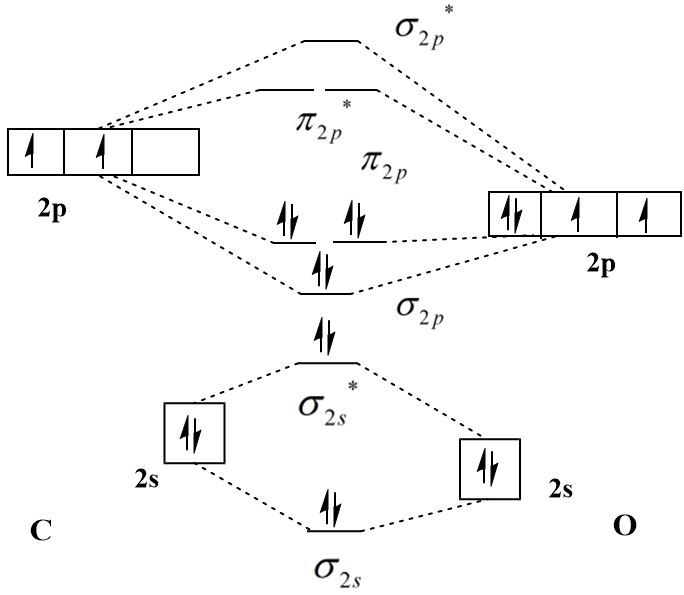
By writing molecular orbital configuration for \[NO,CO\] and \[{{\text{O}}_2}\] molecules calculate the bond order and also determine whether it is paramagnetic or diamagnetic?
Answer
483k+ views
Hint: The bond order is a measure of the number of bonds that exist between two atoms and can be calculated by multiplying the difference of number of electrons present in bonding and antibonding molecular orbitals by half.
Complete answer:
The placement of electrons in bonding or antibonding molecular orbitals can be determined by drawing the molecular orbital diagram of the molecule. This diagram is the virtual representation of the linear combination of atomic orbitals that combine to give molecular orbitals. The molecular orbital configuration can be written with the help of the following diagrams.
The molecular orbital diagram of oxygen molecule \[{{\text{O}}_2}\] is:

The molecular orbital diagram of \[NO\] is:

The molecular orbital diagram of \[CO\] is:

The molecular orbital configuration of oxygen molecule \[{{\text{O}}_2}\] is:
\[{\sigma _{2s}}^2{\sigma _{2s}}^{*2}{\sigma _{2p}}^2{\pi _{2p}}^4{\pi _{2p}}^{*2}\]
The molecular orbital configuration of \[NO\] is:
\[{\sigma _{2s}}^2{\sigma _{2s}}^{*2}{\sigma _{2p}}^2{\pi _{2p}}^4{\pi _{2p}}^{*1}\]
The molecular orbital configuration of \[CO\] is:
\[{\sigma _{2s}}^2{\sigma _{2s}}^{*2}{\sigma _{2p}}^2{\pi _{2p}}^4\]
The following formula can be used to calculate the bond order:
\[{\text{bond order}} = \dfrac{{{\text{bonding electrons}} - anti{\text{ - }}bonding{\text{ electrons}}}}{2}\]
The number of bonding electrons in oxygen molecule is eight and the number of antibonding electrons is four therefore the bond of oxygen molecule is:
\[{\text{bond order}} = \dfrac{{8 - 4}}{2} = 2\]
There are eight bonding electron in nitrogen monoxide and three antibonding electrons therefore the bond order of nitrogen monoxide molecule is:
\[{\text{bond order}} = \dfrac{{8 - 3}}{2} = 2.5\]
The number of bonding electrons in carbon monoxide is eight and that of antibonding electrons is two and therefore the bond order is:
\[{\text{bond order}} = \dfrac{{8 - 2}}{2} = 3\]
The presence of an unpaired electron in the highest occupied molecular orbital (HOMO) of \[{{\text{O}}_2}\] and \[NO\] makes them paramagnetic and the absence of unpaired electrons in \[CO\] makes it diamagnetic.
\[ \Rightarrow \] Hence, the bond order for \[NO\] , \[CO\] and \[{{\text{O}}_2}\] are \[2.5,3\] and \[2\] respectively. Oxygen and nitrogen monoxide are paramagnetic and carbon monoxide is diamagnetic.
Note:
The atomic orbitals are not placed along the same horizontal axis if the atoms involved have an electronegativity difference. The atomic orbitals of oxygen atoms always occupy relatively lower positions due to its higher electronegativity as compared to carbon and nitrogen atoms.
Complete answer:
The placement of electrons in bonding or antibonding molecular orbitals can be determined by drawing the molecular orbital diagram of the molecule. This diagram is the virtual representation of the linear combination of atomic orbitals that combine to give molecular orbitals. The molecular orbital configuration can be written with the help of the following diagrams.
The molecular orbital diagram of oxygen molecule \[{{\text{O}}_2}\] is:

The molecular orbital diagram of \[NO\] is:

The molecular orbital diagram of \[CO\] is:

The molecular orbital configuration of oxygen molecule \[{{\text{O}}_2}\] is:
\[{\sigma _{2s}}^2{\sigma _{2s}}^{*2}{\sigma _{2p}}^2{\pi _{2p}}^4{\pi _{2p}}^{*2}\]
The molecular orbital configuration of \[NO\] is:
\[{\sigma _{2s}}^2{\sigma _{2s}}^{*2}{\sigma _{2p}}^2{\pi _{2p}}^4{\pi _{2p}}^{*1}\]
The molecular orbital configuration of \[CO\] is:
\[{\sigma _{2s}}^2{\sigma _{2s}}^{*2}{\sigma _{2p}}^2{\pi _{2p}}^4\]
The following formula can be used to calculate the bond order:
\[{\text{bond order}} = \dfrac{{{\text{bonding electrons}} - anti{\text{ - }}bonding{\text{ electrons}}}}{2}\]
The number of bonding electrons in oxygen molecule is eight and the number of antibonding electrons is four therefore the bond of oxygen molecule is:
\[{\text{bond order}} = \dfrac{{8 - 4}}{2} = 2\]
There are eight bonding electron in nitrogen monoxide and three antibonding electrons therefore the bond order of nitrogen monoxide molecule is:
\[{\text{bond order}} = \dfrac{{8 - 3}}{2} = 2.5\]
The number of bonding electrons in carbon monoxide is eight and that of antibonding electrons is two and therefore the bond order is:
\[{\text{bond order}} = \dfrac{{8 - 2}}{2} = 3\]
The presence of an unpaired electron in the highest occupied molecular orbital (HOMO) of \[{{\text{O}}_2}\] and \[NO\] makes them paramagnetic and the absence of unpaired electrons in \[CO\] makes it diamagnetic.
\[ \Rightarrow \] Hence, the bond order for \[NO\] , \[CO\] and \[{{\text{O}}_2}\] are \[2.5,3\] and \[2\] respectively. Oxygen and nitrogen monoxide are paramagnetic and carbon monoxide is diamagnetic.
Note:
The atomic orbitals are not placed along the same horizontal axis if the atoms involved have an electronegativity difference. The atomic orbitals of oxygen atoms always occupy relatively lower positions due to its higher electronegativity as compared to carbon and nitrogen atoms.
Recently Updated Pages
Derive the formula for equivalent capacitance when class 12 physics CBSE

What is sex linkage Explain colour blindness and h class 12 biology CBSE

Two harmonic waves of monochromatic light Y1 a coswt class 12 physics CBSE

What is diffraction of light Explain its two types class 12 physics CBSE

Describe the Mendels Law of Segregation with the help class 12 biology CBSE

Discuss three merits and three demerits of the FirstPastthePost class 12 social science CBSE

Trending doubts
What are the major means of transport Explain each class 12 social science CBSE

Which are the Top 10 Largest Countries of the World?

Draw a labelled sketch of the human eye class 12 physics CBSE

Explain sex determination in humans with line diag class 12 biology CBSE

The pH of the pancreatic juice is A 64 B 86 C 120 D class 12 biology CBSE

Explain sex determination in humans with the help of class 12 biology CBSE




